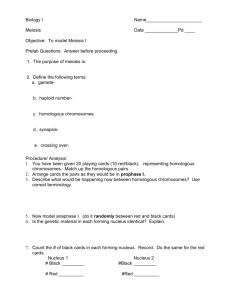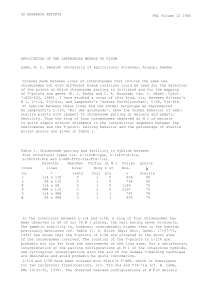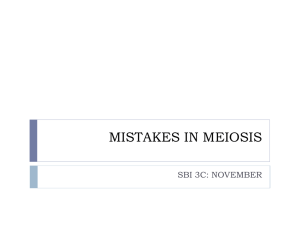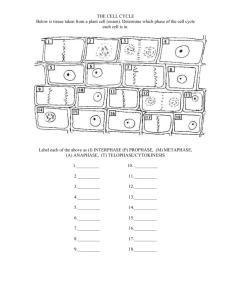pairing competition between identical and homologous
advertisement
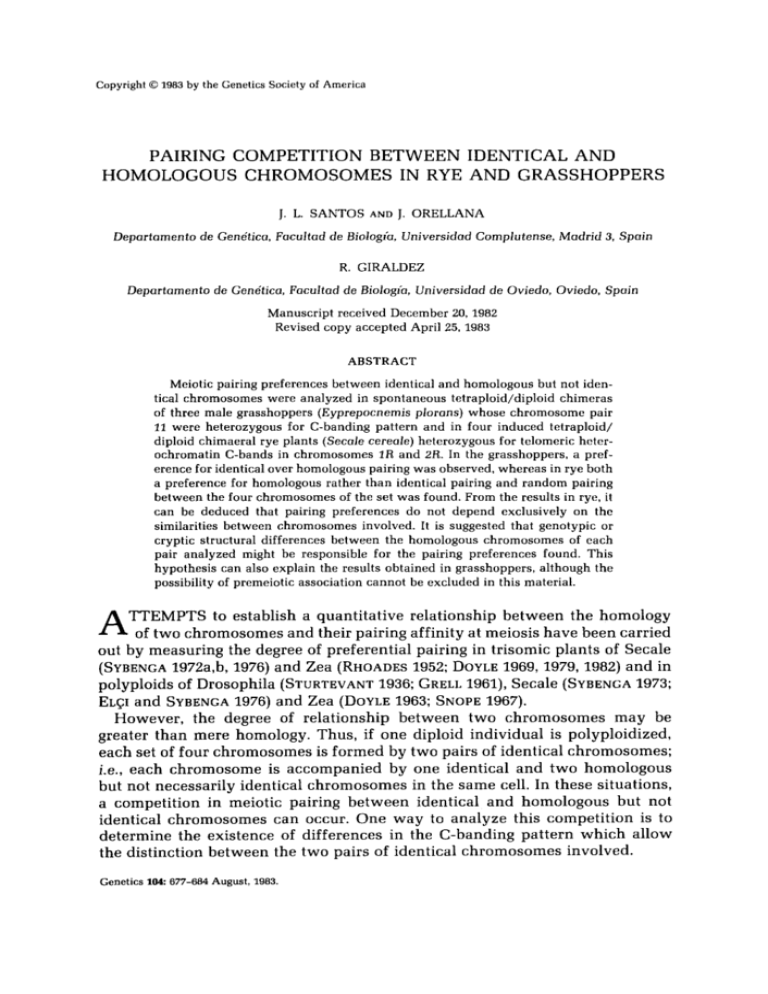
Copyright 01983 by the Genetics Society of America PAIRING COMPETITION BETWEEN IDENTICAL AND HOMOLOGOUS CHROMOSOMES IN RYE AND GRASSHOPPERS J. L. SANTOS A N D J. ORELLANA Departomento de Genetica, Facultod de Biologia, Universidod Complutense, Madrid 3, Spain R. GIRALDEZ Departamento de Genetica, Facultod de Biologio, Universidad de Oviedo, Oviedo, Spain Manuscript received December 20,1982 Revised copy accepted April 25, 1983 ABSTRACT Meiotic pairing preferences between identical and homologous but not identical chromosomes were analyzed in spontaneous tetraploid/diploid chimeras of three male grasshoppers (Eyprepocnemis plorans) whose chromosome pair 11 were heterozygous for C-banding pattern and in four induced tetraploid/ diploid chimaera1 rye plants (Secale cereale) heterozygous for telomeric hcterochromatin C-bands in chromosomes 1 R and 2R. In the grasshoppers, a preference for identical over homologous pairing was observed, whereas in rye both a preference for homologous rather than identical pairing and random pairing between the four chromosomes of the set was found. From the results in rye, it can be deduced that pairing preferences do not depend exclusively on the similarities between chromosomes involved. It is suggested that genotypic or cryptic structural differences between the homologous chromosomes of each pair analyzed might be responsible for the pairing preferences found. This hypothesis can also explain the results obtained in grasshoppers, although the possibility of premeiotic association cannot be excluded in this material. TTEMPTS to establish a quantitative relationship between the homology A of two chromosomes and their pairing affinity at meiosis have been carried out by measuring the degree of preferential pairing in trisomic plants of Secale (SYBENGA 1972a,b, 1976) and Zea (RHOADES1952; DOYLE1969, 1979, 1982) and in 1936; GRELL 1961), Secale (SYBENGA 1973; polyploids of Drosophila (STURTEVANT ELCIand SYBENCA 1976) and Zea (DOYLE 1963; SNOPE 1967). However, the degree of relationship between two chromosomes may be greater than mere homology. Thus, if one diploid individual is polyploidized, each set of four chromosomes is formed by two pairs of identical chromosomes; i.e., each chromosome is accompanied by one identical and two homologous but not necessarily identical chromosomes in the same cell. In these situations, a competition in meiotic pairing between identical and homologous but not identical chromosomes can occur. One way to analyze this competition is to determine the existence of differences in the C-banding pattern which allow the distinction between the two pairs of identical chromosomes involved. Genetics 104:677-684 August, 1983. 678 J. L. SANTOS, J. ORELLANA AND R. GIRALDEZ GIRALDEZ and SANTOS(1981) observed a preference for meiotic pairing between identical rather than homologous chromosomes in a spontaneous tetraploid/diploid chimera male grasshopper (Euchorthippus pulvinatus) that was heterozygous for a C-heterochromatin segment in chromosome pair 8. According to SYBENGA (1976), the excess of bivalents formed by identical chromosomes could be explained by either sequence specificity differences or efficiency or activity differences between chromosomes. In this paper, we present new data about identical and homologous pairing in spontaneous tetraploid/diploid chimeras of three males of the grasshopper Eyprepocnemis plorans and in induced tetraploid/diploid chimaera1 rye plants that were heterozygous for telomeric heterochromatin C-bands in chromosomes 1R and 2R. MATERIALS AND METHODS Grasshoppers: The tetraploid cells analyzed appeared spontaneously in the testes of three males of natural Spanish populations of E. plorans, two collected near Arcnillas (Cadiz) and one near Fuengirola (MBlaga) in September 1981. The testes were fixed in 1:3 acetic ethanol, squashed and stained following the Giemsa C-banding technique described previously (SANTOS and GIRALDEZ 1978). Rye: Plants heterozygous for a telomeric C-band in the long arm of chromosome 1R formed the material for this study. Their origins were as follows: and GIRALDEZ 1981). 1. A rye cultivar taken from La Raiia, Logrosan (Caceres, Spain) (ORELLANA 2. The FI of a cross between two inbred lines P and R. These plants were also heterozygous for a telomeric C-band in the short arm of chromosome 2R. 3. The backcross between F1 (P X E) (GIRALDEZ and ORELLANA 1979) and the inbred line E. At the three-leaf stage, seedlings were treated with colchicine using the technique described by THOMAS and PICKERINC (1979). Four of the treated plantlets turned out to be tetrapoloid/diploid chimeras: one of La Raiia cultivar (3i26),two of the FI cross P X R (FIPRIand FIPR2)and one of the backcross (P X E) X E (RIPEE). Anthers of the emerging spikes were stained in 2% acetic orcein and squashed in 1%acetic orcein to determine their diploid or tetraploid chromosome constitution. Those spikes which turned out to be tetraploids were fixed in 1:3 acetic ethanol and stored for several months before examination. The fixed materials were squashed and stained following the Giemsa C-banding technique described previously (GIRALDEZ and ORELLANA 1979). RESULTS Grasshoppers: E. plorans has 23 chromosomes (22 + X) in the male and 24 chromosomes (22 + XX) in the female. In addition to the C-heterochromatin which is present in the centromeres of all chromosomes, the two members of several chromosome pairs can also show paracentromeric C-bands of different sizes. Moreover, this species presents a polymorphic system of B chromosomes (HENRIQUES-GIL, SANTOSand GIRALDEZ 1982). The individuals analyzed were heterozygous for the C-banding pattern of chromosome 11; one member of this pair showed a large paracentromeric C-band; the other did not (Figure la). Polyploid metaphase I cells appeared in only a single tubule of the testes in each individual analyzed; however, since metaphase I cells are rare, we could not ascertain whether the entire cyst was polyploid. In all cells, the chromosomes 11 always formed bivalents. In these polyploid cells, each chromosome had one identical and two homol- IDENTICAL VS. HOMOLOGOUS PAIRING 679 FIGURE1.-Metaphase I cells of E. plorons. a, Diploid cell; the two chromosomes forming bivalent 11 show different handing patterns. Arrows indicato B ~ h r ~ m o s o m b. c ~Tetraploid , cell; the two bivalents 11 are formed by the pairing of idontical chromosomos. Arrows indicate B chromosomes. ogous partners. So, if pairing (and crossing over) between the four partners were at random, one would expect the number of bivalents formed by homologous chromosomes to be twice the number of bivalents formed by identical ones. Table 1 shows the frequencies of identical and homologous bivalents in the different tetraploid/diploid chimeras of E. plorans. A highly significant deviation from random was observed; bivalents formed by identical chromosomes were in excess (Figure lb). Rye: The analysis of polyploid meiotic cells in rye was more complicated than in grasshoppers, since the 1R and 2R chromosomes formed both bivalents and quadrivalents. When these chromosomes formed quadrivalents, the two types of pairing (identical and homologous) between chromosome arms heterozygous for C-telomeric heterochromatin (ZR’, and 2RS) could be distinguished in most of the meiotic configurations (Figure 2a) except those in which three or four 1. 680 L. SANTOS, 1. ORELLANA A N D R. CIRALDEZ TABLE 1 Frequencies of itlenticol and homologous hivcilcnts in thc tliffcrenl tctroploitl/ tliploitl chimeras of E. plorans a n d E. pulvinatus Itlc:nticiil Homologous ChromciIntlivitluiil somc: A4-1 F-44 11 11 A4-A I1 8 E24" No. o f cclls Ohsc!rvc:cl Expi:c:tc:tl 15 12 27 64 15 9 26 60 5 4 9 21.33 Obscrvctl Expcctc:tl 0 3 10 U 1u 42.60 1 4 X? 30.00" 4U.16" 105.15" GIRALDEZ and SANTOS(1981). * * Significant at the level of 1%. a FIGURE 2.--Diffcrcnt meiotic configurations observed for I R and 2R chromosomcs in tclraploid mciocytcs of ryc. a. Chromosomc arms 1R'. and 2R" show homologous pairing. b. Quadrivalent 1R showing undetermined pairing in lhc long arm. c. Quadrivalent I R showing identical pairing in thc long arm. d. Tho two bivalents I R arc formod by the pairing of identical chromosomes. c. The two bivalents I R arc formed by the pairing of homologous chromosomes. IDENTICAL VS. HOMOLOGOUS PAIRING 681 chromosomes were paired in the same region (undetermined pairing) (Figure 2b). The type of pairing between chromosome arms without C-telomeric heterochromatin (ZRS and 2 R L ) was distinguishable in very few meiotic configurations (Figure 2c). When these chromosomes formed bivalents, it was always possible to distinguish the bivalents formed by identical chromosomes (Figure 2d) and those formed by homologous but not identical chromosomes (Figure 2e). For these reasons, only the frequencies of identical and homologous bonds for chromosome arms l R L and 2R” in bivalents and quadrivalents were analyzed. In some plants (RIPEE, 3i26) random pairing between identical and homologous chromosome arms was observed; however, in plant F1 PR1 there was a significant deviation from random due to an excess of homologous bonds (Table 2 ) . In plant FlPR2 the ZRL arms paired randomly, whereas for 2RS homologous pairing was favored over identical; however, this apparent “mixed” pairing behavior must be considered carefully since it may also be an artifact due to the low number of cells scored. DISCUSSION Cases in which pairing is restricted to molecularly identical copy chromosomes have been reported (DRISCOLL, DARVEYand BARBER1967; SHAWand WILKINSON 1978). In such cases polyploidy was induced in the last premeiotic mitosis; pairing preferences were accounted for in terms of the close proximity of the recently formed identical chromosomes when the pairing process was initiated. GIRALDEZ and SANTOS (1981) also described pairing preferences for identical over homologous chromosomes in a spontaneous tetraploid/diploid chimera of an E. pulvinatus male. However, in their case the number and location of the polyploid cells indicated that a complete cyst was affected, so the cell in which polyploidy arose underwent at least seven premeiotic mitoses before the resulting cells entered meiosis. Nevertheless, the existence of premeiotic association could not be excluded. The results could also be explained either by specificity, with the small differences between related chromosomes being recognized during the pairing process or by differences between chromosomes in efficiency or activity, with one of the chromosome types being more effective in pairing than the other, or starting to pair earlier; there would be a preference for the most active ones to find each other. Other examples of preferential pairing have been reported in autotetraploid 1967) and rye (ELGIand SYBENGA 1976). plants of corn (DOYLE1963; SNOPE However, these situations cannot be compared exactly to the tetraploid cells studied in this paper. In corn each set of four chromosomes was not formed by two pairs of identical ones, because the autotetraploid plants were derived from crosses of asynaptic diploids, which produced diploid eggs, with tetraploids. In the tetraploid hybrids of rye, pairing preference between identical and homoeologous (instead of homologous) chromosomes was analyzed. In the autotetraploid rye plants analyzed here, a preference for homologous 682 J. L. SANTOS, J. ORELLANA AND R. GIRALDEZ TABLE 2 Frequencies of identical and homologous bonds for the long arm of chromosome 1 R untf the short arm of chromosome 2R Chromosome a r m 1 R long 2R short __ -~ Plant I H U X' 1 H U X' FiPRi 43 (116) 21 (21.67) 52 (48.67) 33 (38.33) 305 (232) 44 (43.33) 94 (97.33) 82 (76.77) 12 68.91** 36 (87.33) 8 (14.33) 226 (174.67) 35 (28.67) 1 45.25** FiPR, RiPEE 3126 1 0.03 1 0.34 3 1.11 4.20* The figures in parentheses arc thc expected frequencics. I, Identical pairing; H, homologous pairing: U, undetermined pairing. * Significant at tho lcvcl of 5%; **significant at thc lcvcl of 1%. over identical pairing or a random pairing between the four chromosome arms l R L and 2RS was found. If the different types of pairing found were produced by efficiency or activity differences between chromosomes, this would imply, in our case, that, if in a diploid plant one chromosome presents more potential pairing activity than its homologous one, in the induced tetraploid this chromosome and its identical partner would pair together preferentially. Thus, a preference for identical over homologous pairing would be expected. By contrast, if in the diploid both homologous chromosomes have the same activity or efficiency, in the tetraploid a random pairing between the four partners would be expected. In any case, the homologous pairing preferences found cannot be explained by this assumption. The different pairing affinities observed (Table 2) may be due to the existence of genotypic or cryptic structural differences between the homologous chromosomes of each pair analyzed. One of such structural differences is, obviously, the C-heterochromatin bands present in the chromosome arms studied here. It is well known that inbreeding in rye leads to reduced chromosome pairing, and this has been assumed to be due to homozygosity for recessive low-pairing genes, but perhaps it could be due in part to repulsion between some component(s) of rye chromosomes when homozygous. There is indeed evidence that in wheat-rye amphiploids certain rye chromosomes that have terminal heterochromatin are more subject to pairing failure than the same chromosome lacking the terminal heterochromatin (MERKER 1976; ROUPAKIASand KALTSIKES1977; NARANJOand LACADENA1980). The homologous pairing preferences observed in the present experiment may be explained by homozygosity for the identifying terminal segment of heterochromatin that reduces the probability of identical pairing for the heterochromatin-bearing chromosomes and as a consequence increases the probability of homologous pairing. The degree to which this effect IDENTICAL VS. HOMOLOGOUS PAIRING 683 is expressed is expected to differ between chromosomes carried by different plants (for example, by variation in the amount of heterochromatin that need not to be extensive enough to be cytologically obvious). For some plants (i.e., some chromosomes), the repulsion is so strong that there is an excess of homologous associations; for others, the repulsion is less strong and a n apparently random array results. This latter formulation assumes that the basic preferred pattern in rye is identical and that all plants examined are exhibiting a pattern that is deviant; the alternative-that the basic pattern is random and only those plants that show significant preference for homologous associations are deviant-is equally likely from the results obtained. It is worth mentioning the suggestive hypothesis proposed by DOYLE(1979, 1982) to explain the differential affinity of pairing found in trisomic and tetraploid plants of corn. This author assumes that certain segments of a chromosome may act as synaptic initiators. These segments may have highly repeated pairing units and the number of these units determines the pairing strength. The number may fluctuate because of unequal crossing over or unequal exchange between sister chromatids. In this way, equal numbers of such pairing units in the two homologous chromosomes would lead, after tetraploidization, to random pairing in the four chromosomes of the set; whereas, different numbers would lead to identical pairing preferences. Under this hypothesis, a divergence process of identical chromosomes during the mitotic division between tetraploidization and meiosis is needed to explain the homologous pairing preferences found in this work. On the other hand, if the apparent ‘mixed’ behavior of plant FIPRz were a n artifact of small numbers, one possibility for the cause of the difference between “homologue preference” and “random” would be that the plants differ in some pairing gene-not necessarily on any of the diagnostic chromosomes. We thank J. R. LACADENA,P. ARANA,M. C. C E R M E ~and O N. HENRIQUES-GIL for valuable discussions as well as anonymous reviewers for their constructive comments on the previous draft. This work has been supported in part by a grant of the Comision Asesora de Investigacion Cientifica y Tecnica of Spain. LITERATURE CITED DOYLE,G. G., 1963 Preferential pairing in structural heterozygotes of Zea mays. Genetics 48: 1011-1027. DOYLE, G. G., 1969 Preferential pairing in trisomics of Zea mays. Chromosomes Today 2: 12-20. DOYLE,G. G.,1979 The allotctraploidization of maize. Part 1. The physical basis-differential pairing affinity. Theor. Appl. Genet. 5 4 103-112. DOYLE,G. G., 1982 Thc allotetraploidization of maize. Part 3. Gene segregation in trisomic heterozygotes. Theor. Appl. Genet. 61 81-89. DRISCOLL, C.J., N. L. DARVEY and H. N. BARBER, 1967 Effect of colchicine on meiosis of hexaploid wheat. Nature (Lond.) 216:687-688. ELFI.S. and J. SYBENGA, 1976 Incomplete preferential pairing in a tetraploid Secale hybrids carrying translocations: multivalent configuration frequencies and marker segregation. Genetica 46: 177-182. 684 J. L. SANTOS, J. ORELLANA AND R. GIRALDEZ GIRALDEZ, R. and J. ORELLANA, 1979 Metaphase I bonds, crossing over frequency and genetic length of specific chromosome arms of rye. Chromosoma (Berl.) 72 377-385. GIRALDEZ, R. and J. L. SANTOS,1981 Cytological evidence for preferences of identical over homologous but not-identical meiotic pairing. Chromosoma (Berl.) 82 447-451. GRELL,E. H., 1961 Variation in preferential segregation of chromosome two in triploid females of Drosophila melanogaster. Genetics 4 6 1267-1272. HENRIQUES-GIL, N., J. L. SANTOS and R. GIRALDEZ, 1982 B-chromosome polymorphism and interchromosomal chiasma interference in Eyprepocnemis plorans (Acrididae; Orthoptera). Chromosoma (Berl.) 85:349-359. MERKER, A., 1976 The cytogenetic effect of heterochromatin in hexaploid triticale. Hereditas 8 3 215-222. NARANIO, T. and J. R. LACADENA, 1980 Interaction between wheat chromosomes and rye telomeric heterochromatin on meiotic pairing of chromosome pair 1 R of rye in wheat-rye derivates. Chromosoma (Berl.) 81:249-261. 1981 Metaphase I bound arms and crossing over frequency in rye. ORELLANA, J. and R. GIRALDEZ, I. Open pollinated varieties. Chromosoma (Berl.) 84: 439-449. RHOADES,M. M., 1952 Preferential segregation in maize. pp. 66-80. In: Heterosis, Edited by J . W. GOWEN.Iowa State College Press, Ames. D. G. and P. J. KALTSIKES,1977 The effect of telomeric heterochromatin on chromoROUPAKIAS, some pairing of hexaploid triticale. Can. J. Genet. Cytol. 19 543-548. J. L. and R. GIRALDEZ, 1978 The effect of heterochromatin in chiasma terminalisation in SANTOS, Chorthippus biguttulus L. (Acrididae; Orthoptera). Chromosoma (Berl.) 70 59-66. 1978 “Homologies” between non homologous chromosomes in the SHAW,D. D. and P. WILKINSON, grasshopper Coledia captiva. Chromosoma (Berl.) 6 8 241-259. SNOPE,A. J., 1967 Meiotic behaviour in autotetraploid maize with abnormal chromosome 10. J. Hered. 58: 173-177. STURTEVANT, A. H., 1936 Preferential segregation in triplo-IV females of Drosophila melanogaster. Genetics 21 444-466. I., 1972a Localisation of intraespccific variation in meiotic chromosome pairing. ChroSYBENGA, mosomes Today 3: 104-109. SYBENGA, J., 197213 Chromosome associated control of meiotic pairing differentiation: variation within Secale cereale. Chromosoma (Berl.) 3 9 351-360. SYBENCA, J., 1973 The effect of reciprocal translocations segregation and multivalent formation in autotetraploid of rye, Secale cereale. Genctica 4 4 270-282. SYBENGA, I., 1976 Quantitative variation in chromosome pairing affinities within a species, Secale cereale. pp. 143-150. In: Current Chromosome Research, Edited by K. JONES and P. E. BRANDHAM. Elsevier/North-Holland Biomedical Press, Amsterdam. 1979 Barley X rye crosses: the morphology and cytology of THOMAS, H. M. and R. A. PICKERING, the hybrids and the amphiploids. Z. Pflanzenzuchtg. 82: 193-200. Corrcsponding editor: A. T. C. CARPENTER





